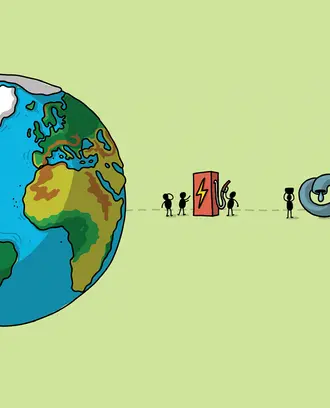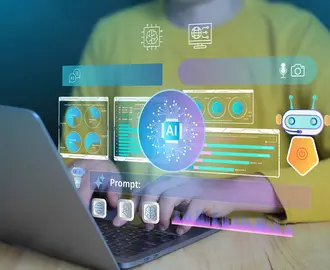Credit: Mimi Phan / iStock
When evaluating green technologies, wary consumers rely on social learning
The average price of an electric vehicle in 2023 was roughly $54,000 — a steep figure for many consumers. To buoy the market and promote more environmentally beneficial products, the U.S. government offers up to $7,500 in subsidies for new EVs.
This helps, but EV purchases are still relatively anemic, in part because economics aren’t the only roadblock to their adoption. Green technologies are novel, and consumers have reservations. In the case of EVs, consumers have range anxiety as they fear a dearth of charging stations. They are also unsure about the ownership experience; compared with conventional gasoline-powered vehicles, EVs have faster and quieter acceleration and need less maintenance, but battery replacement costs are high.
To resolve these uncertainties, consumers read product reviews on websites like Kelley Blue Book or Edmunds. They talk to friends who jumped into the market early, or they defer to local initiatives that facilitate information sharing. They engage in what’s known as social learning and do what they can to educate themselves.
“Social learning happens every day and becomes more important as we get more data from new technologies,” said University of Tennessee professor Tingliang Huang. “With all this information, customers make purchase decisions differently from before. Thus, a pressing challenge for policymakers and firms is to better understand the effects of social learning and use this valuable data to effectively manage green product adoption.”
New research by Huang, MIT Sloan professor and interim dean and George Mason University professor Hang Ren found that government subsidies can be more effective if they take into account the role of social learning in consumer decision-making. Counterintuitively, the researchers also found that efforts to increase the adoption of green technologies through consumer education can ultimately backfire.
Modeling the market
The researchers developed a model that captures the dynamics of a market for novel green technologies such as EVs and solar panels. In the model, a government determines a purchase subsidy, a company decides how many units to manufacture, and then two waves of consumers decide whether to purchase the new technology, with the second wave taking advantage of product reviews from the first wave.
The government’s objective in offering subsidies is to maximize social welfare, the researchers note, which in this case takes into account:
- Consumer surplus, which is the difference between what a consumer is willing to pay for a product and the actual price they end up paying.
- Supplier profits, or how much companies profit from sales of a product.
- Environmental benefits from additional adoption of green technologies.
- The cost to the government of offering subsidies.
The interaction among these groups revealed two main insights. First, social learning among consumers does not necessarily improve overall welfare. In fact, Perakis and her colleagues found that giving consumers information about a new technology can actually lower welfare.
This happens for supply and demand reasons. On the supply side, social learning makes the demand more uncertain for the supplier, who makes a capacity investment before knowing whether reviews will be favorable. The prospect of unfavorable reviews that would depress demand could lead suppliers to reduce output, but if the reviews then turned out to be positive, the environmentally beneficial technology would not be available to meet the unexpected demand. On the demand side, if reviews are favorable, the demand may exceed supply, and customers who would benefit only slightly from adopting the product might crowd out those who would benefit more.
The second key insight regards how the particulars of a product and its market should inform the design of subsidies. The researchers found that governments should consider a rising path — meaning lower subsidies at the outset that increase as time passes — if the market is likely to be small. Conversely, the subsidies’ path should decline over time if the market is likely to be large and the social welfare benefits of adopting the new technology are substantial. The researchers noted that these recommendations only capture the impact of social learning, but there are other factors that affect subsidies.
“These guidelines are driven by the strategic interactions among government subsidies, supplier capacity, and customer purchase decisions jointly shaped by social learning,” Ren said. “When the market size is likely to be small, for example, the crowding-out effect is more prominent, to the detriment of social welfare. So the government should lower subsidies at the outset to discourage social learning and increase subsidies later to incentivize additional capacity supply.”
Strategic use of information and subsidies
Based on this research, governments should try to adapt their subsidies over time to suit the dynamics of the market — whether it’s large or small and whether reviews of a given technology are favorable or not. The researchers call this a “flexible subsidies” approach.
Related Articles
Using real-world data from the EV market, Perakis and her colleagues studied the benefit of adopting flexible subsidies. They found that, done properly, this approach could improve overall social welfare by as much as 5.7%; on average, it increases by 1.1%.
“The considerable benefits would prompt governments to consider implementing flexible subsides despite potential implementation burdens,” Ren said. “The benefits are multifaceted. When reviews are favorable, the government can lower subsidies to preempt the crowding-out effect. When reviews are unfavorable, the government can increase subsidies to promote adoption. Further, we find that flexible subsidies can incentivize additional capacity supply.”
The results of this work point to the need for governments to incorporate social learning into how they establish and manage subsidies, and demonstrate the potential for enhancing social welfare using real-world data. There are also implications for community outreach events and organizations centered on green technologies, like National Drive Electric Week, which advocates for EV adoption, or Solarize, which encourages the installation of residential solar panels through community-led education.
“Although well-intentioned efforts like these may promote social welfare, the organizations should exercise discretion based on the specific product and market conditions,” Ren said. “When the market is likely to have a large size and the welfare benefits of adoption are substantial, promoting social learning through these activities improve social welfare by incentivizing capacity supply and consumer purchases when reviews are favorable. Otherwise, the well-intentioned efforts backfire.”
Read next: Why Impact Investors are Embracing Systems Change



